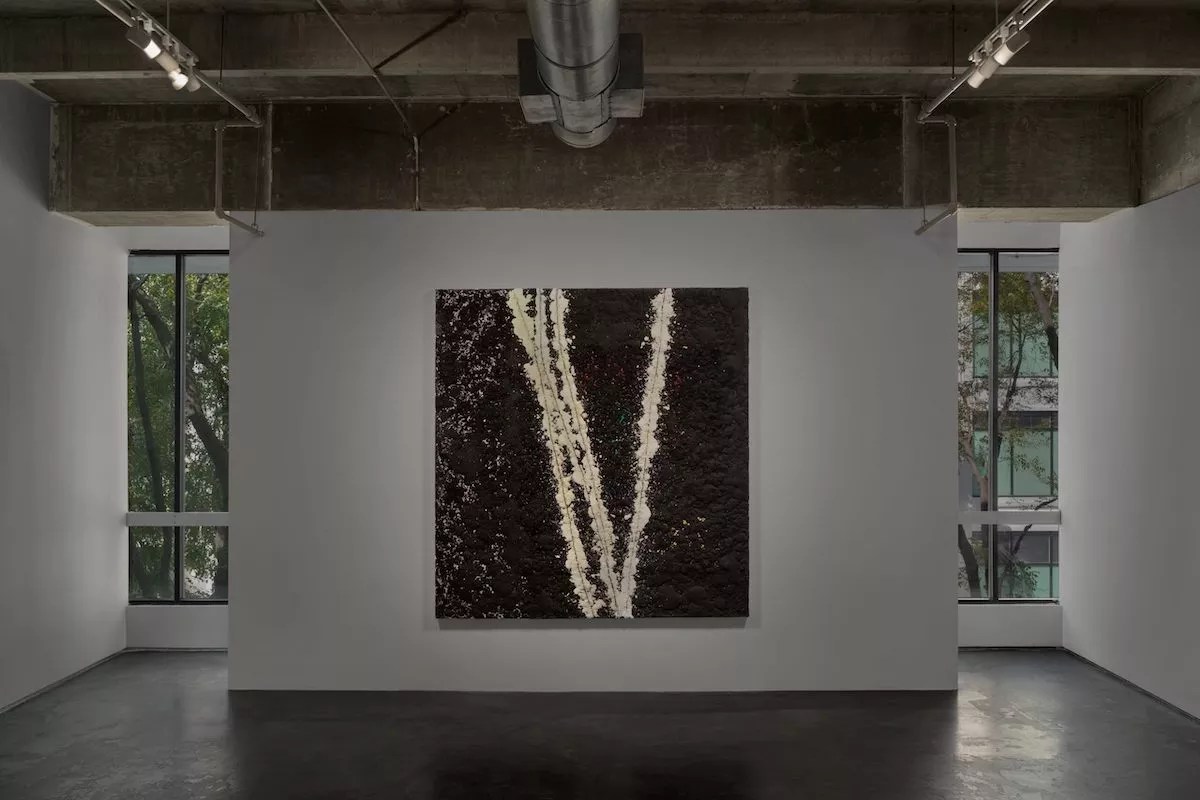
Courtesy of the artist and David Castillo/Photo by Zach Balber

Audio By Carbonatix
Vaughn Spann’s solo exhibition at the David Castillo Gallery in the Design District, “In Search of Solitude,” greets visitors with an empty room housing a single painting. Composed of polymer paint and mixed media on canvas, the seven-by-six-and-a-half-foot canvas, Composition in Black (Nocturne No. 2 in C Minor), stands alone in the barren gallery.
Building on the Florida-born artist’s method, which merges traditional painting techniques rooted in formalism, color field painting, and minimalism with a conscious utilization of materials and resources, the curation helps to challenge the limitations of painting as a vehicle of significance. The result is the experience the viewer has alone in the gallery with the artwork: an unsettling encounter with intricately textured surfaces that bear the weight of the artist’s reflections on the current era.
As with many of his earlier pieces, Spann’s affinity for unconventional materials is attested by the work’s striking composition. The canvas is composed of two distinct sections. The first layer is the background or foundation, consisting of a subtle interplay of purple hues juxtaposed with bright reds, greens, and yellows, which, while noticeable, appear to have been applied thinly, suggesting a restrained energy. Above the first layer is an aggressive application of black paint and white streaks, giving a sense of active repression of the underlying tones. The thickness of the paint heightens the effect and gives the visceral impression it was hurled at the canvas. The work’s textured surface extends beyond the face of the piece, creating a three-dimensional exterior that conveys a tactile sense of rocks or sediment. Certain areas of the canvas are less heavily painted, creating a feeling of fadedness or weathering that suggests the work’s existence within a larger continuum.
Spann’s works are not standalone statements but rather part of an ongoing dialogue, with each exhibition serving as an extension of the existing conversations surrounding his art. Composition in Black, for example, builds upon earlier pieces like Nature (2020) in its use of texture and representation while employing the symbolic language characteristic of his body of work. Marked Man (Mitchell) (2019) and his Dalmatian Painting series allow his art to take on a charged language, imbuing his canvases and wood panels with inherited meaning from the artist’s experiences while complicating any familiar identifications a viewer may have with them.
On Composition in Black, one can discern white lines that appear to form a letter, resembling an abstracted version of a V or an X. The latter could signal the continuation, or a reformulation, of Spann’s well-known Marked Man series – a group of paintings characterized by monumental X symbols surrounded by textured backgrounds. The ongoing series, of which Marked Man (Mitchell) is a part, is deeply connected to the artist’s experiences as a victim of racial profiling, with the X echoing the gesture he took – hands up, legs split – during a stop and frisk encounter with the police while a student at Rutgers University in New Jersey. Throughout the paintings, the symbol plays a prominent role, filling the length of the canvas with highly textured surfaces and acting as a common thread that ties the pieces together. However, like much of his work, clear-cut interpretations are elusive. Instead, the pieces invite multiple, sometimes conflicting, readings, which may well be what Spann intends. By keeping his dialogue with the audience open-ended, he enables ongoing and dynamic engagement with his art.
What’s particularly striking about Spann’s approach is his fluidity. He employs a language of oscillation, and his pieces feel like explorations of perception and meaning through color and space. Through this, he achieves universality, drawing on inherited spaces while pushing beyond the boundaries of individual experience. In many ways, the gallery space becomes a canvas for Spann’s explorations, allowing for various interpretations that emerge as a collaborative effort between the painting and the viewer. This sense of shared experience is vital to Spann’s approach, as he sees his exhibits not as singular punctuations but rather as part of an ongoing conversation that builds upon itself, constantly evolving and expanding. The result is a body of work that is both cohesive and endlessly dynamic, each piece contributing to a larger whole that speaks to the fundamental human experiences of perception, interpretation, and meaning-making.
Entering the gallery from the neighborhood’s busy streets, Spann’s solo exhibition invites immediate immersion in materiality and stillness, pushing the viewer to consider his work as much for its physical features as for its ability to induce contemplation. Confronting it in the barren gallery, the viewer is offered a chance to surrender to a different, more intimate, artistic experience.
“Vaughn Spann: in Search of Solitude.” On view through May 16, at the David Castillo Gallery, 3930 NE Second Ave., Suite 201, Miami; 305-573-8110; davidcastillogallery.com. Admission is free. Tuesday through Saturday 10 a.m. to 6 p.m.